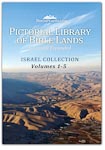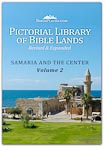 |
|
|
BiblePlaces Newsletter
Vol 11, #3 - November 12, 2012
In more than ten years of
newsletters, I was surprised to see that we have never featured photos of
the Jezreel Valley. While it's true that the average tour in Israel
pretty much skips right through this area, the biblical student loves
this valley because it is so rich in history! How I've managed to avoid
it in the newsletter for a decade now is a mystery.
We also decided to highlight one of the great
features of the Pictorial Library of Bible Lands--identifying
labels. While these are not entirely "new," we've added so many
throughout the collection that it almost qualifies as a new feature. Our
photos below of the Jezreel Valley give you a sense for how helpful the labels
can be.
This is just one of
many great
reasons to purchase the collection or to upgrade. If you're
wondering what all is included, you can see
a summary here. If you want to see more free
photos, click here.
If you have questions about upgrading, check out
our answers. If you
have other questions,
send us an email; we'd love to help.
We will have a booth at this
week's conference of the Evangelical Theological Society in Milwaukee.
If you're there, stop by, say hi, and see why we're so excited.
Todd Bolen
Photographer,
BiblePlaces.com
Editor,
LifeintheHolyLand.com
Feature Highlight: Labels
The best way to understand the
value of these new labels is to see them on the photos. For that, check
out the featured photos below. We might add a few comments:
1. In the Pictorial Library of
Bible Lands, the labels are in the PowerPoint presentations. That
means that they are easily modified or deleted. You may want to draw a
big circle around one area and delete a label for a site you're not
interested in. That'll take you a couple of seconds. that they are easily modified or deleted. You may want to draw a
big circle around one area and delete a label for a site you're not
interested in. That'll take you a couple of seconds.
2. Besides cities and mountains,
we've added labels for roads, passes, architectural features, wadis, and
sometimes even sites no longer preserved. One of
my favorites is the labels on the Dead Sea Scroll caves. I don't know of
any other place where you can see every cave identified.
3. Each slide that is labeled also
comes without the labels. This is helpful when labels may obscure a
feature or when you just want to enjoy the photo without any
distractions.
Unless you know an awful lot about
the biblical lands, we predict that you'll learn some fun and
fascinating facts as you benefit from our years of travel and research.

News from the BiblePlaces Blog...
New Video: An Exciting New Dig at Abel Beth Maacah
- This short video might convince you to sign up for next summer's
excavation...
Wednesday Roundup - Digging at Carchemish, exploring
Shiloh, and rejecting the Mary's Well Hotel...
Ancient Cedar Beams on Temple Mount - Are they going up in
smoke?...
Three Free Years of the Palestine Exploration Quarterly -
Along with a link for free access, I point out some recent articles of
interest...
Trail around the Sea of Gailee - Most of the 40-mile
lakeshore path is now open...
New Excavation Planned for City of David - The liberal Tel
Aviv University just can't resist getting involved, but that doesn't
mean that everyone is happy...
And more...
Picture of the Week
If you are not a regular reader of our blog, you'll want
to
check out a new series written by Seth M. Rodriquez. Each Thursday
he selects a photograph (or three) and tells a story about it. He show
how "a picture is worth 1,000 words."
Here are some quick links to recent posts in the series:
Signs of the Holly Land (pun intended) - An
entertaining look at creations of man in the biblical world...
Treading Winepress - It's hard to keep the juice off your
clothes...
Seven Species Display - One photo shows them all...
Pompeii, House of Sallust, Atrium - An ancient house can
help you understand 1 Corinthians 11...
Patmos, View of Island Panorama - I wouldn't mind exile on
this island if I had a view like this every day...
And more...
Featured BiblePlaces Photos:
The Jezreel Valley
Jesus traveled through the
Jezreel Valley. Nearly everyone in ancient Israel, for that matter,
traveled through the Jezreel Valley. Kings and judges, armies and
merchants, all on their way somewhere, would have passed through
Israel's "Grand Central Station."

I wonder what stories Jesus
might have told his disciples as they crossed the valley. I wonder what
stories the faithful Joseph might have told young Jesus as they journeyed
through on their way to Jerusalem. This month's featured
photos highlight a few of those true, life-changing stories that
have been told for generations.
All of the photos below are available, with their captions, in a
free PowerPoint presentation. The
presentation includes the photos with and without the labels.
A limited version is
also available
in pdf format.
Readers are
welcome to use these images for personal study and teaching.
Commercial use requires separate permission. For more
high-quality, high-resolution photographs and illustrations of biblical
sites, purchase the
Pictorial Library of
Bible Lands or the
Historic Views of
the Holy Land collections. |
|
Jezreel Valley from Mount
Carmel
|
|

Click photograph for higher-resolution version. Download
the
PowerPoint presentation for all of the photos. |
The view of the Jezreel Valley from the summit of Mount Carmel
is spectacular. Elijah and the prophets of Baal would have had
such a view just before fire came down from heaven (1 Kings
18). The city of Jokneam just below might have brought back
memories of "Jokneam in Carmel," the home of one of the kings
defeated in the conquest of Joshua (Joshua 12:22).
|
|
Jezreel Valley from Nazareth Ridge |
|

Click photograph for higher-resolution version. |
From the ridge just above Jesus'
hometown, the valley of Jezreel spreads out from east to west.
To the left, Barak fielded his army of 10,000 Israelite soldiers
to face Sisera and the Canaanites. The fields that day were awash
with mud and blood (Judges 4-5). To the south, a law-breaking lady
living in Endor was surprised one night first to see Saul and then
to see Samuel (1 Samuel 28). Jesus too would raise someone from
the dead on the northern slope of the Hill of Moreh (Luke
7:10-17).
|
|
Hill of Moreh and Mount Tabor |
|

Click photograph for higher-resolution version. |
If Gideon had been 1,000 feet up, he would have
seen even more clearly the terrifying hordes of the Midianites who
came "like swarms of locusts" and camped "in the valley near the
hill of Moreh" (Judges 6:5; 7:2). God used one who was like a
"loaf of barley...tumbling into the Midianite camp" to glorify
himself as the Warrior of Israel (Judges 7:2, 13). To the north,
Jesus might have pointed and quoted, "Tabor and Hermon sing for
joy at your name" (Psalm 89:12).
|
|
Mount Gilboa and Jezreel |
|

Click photograph for higher-resolution version. |
For centuries Israel longed for a king. The years
of the judges were known as the "days Israel had no king; everyone
did what was right in his own eyes" (Judges 21:25). Alas, things
did not go much better under the nation's first king, and the
"glory of Israel" was slain on Mount Gilboa, an utter failure both
spiritually and militarily (1 Samuel 31-2 Samuel 1). At the western tip of Mount Gilboa,
Jezreel was home to the vineyard of Naboth (1 Kings 21). After
Queen Jezebel engineered Naboth's death, she was thrown from a
window to be trampled by horses and eaten by dogs (2 Kings
9:30-37).
|
|
The Harod Valley from Mount
Gilboa |
|

Click photograph for higher-resolution version. |
The Harod Valley lies between Jezreel
and Beth Shean, and it was the route that Jehu traveled as he drove
his chariot "like a madman" from Ramoth Gilead (2 Kings 9:20).
According to
one writer, Jesus is "the greater Jehu," and he is
talking about more than his driving skills. Whether or not Jesus recalled
that story with his disciples, it does seem likely that this was the
place where Jesus healed the 10 lepers, only one of whom returned to
offer thanksgiving (Luke 17:11-19).
|
|
Megiddo |
|

Click photograph for higher-resolution version. |
Megiddo was just a mound of
ruins in Jesus' day, but the memories of bloodshed no doubt remained.
Two of Jesus' kingly ancestors, after all, died at Megiddo, including
the righteous Josiah (2 Kings 9:27; 23:29). If Jesus and his disciples could have dug
through the dirt they would have seen ancient stables and silos,
temples and a tunnel. In John's vision of the revelation of Jesus, he
foresaw the day when kings would again gather at Armageddon to destroy
Israel (Rev 16:16).
|
|
|
SHARE THIS NEWSLETTER
There are people who would love to read this newsletter but they don't
know about it. Would you mind helping them and helping us by forwarding it
to them? They can subscribe to this newsletter
here.
The BiblePlaces Newsletter is cost-free and spam-free. Email addresses will never be used for any purpose
other than this newsletter. If you have questions about the
subscription process, see
this page.
All contents ? 2012 Todd Bolen. Text and
photographs may be used for personal and educational use. Commercial use requires written permission.
|
|

